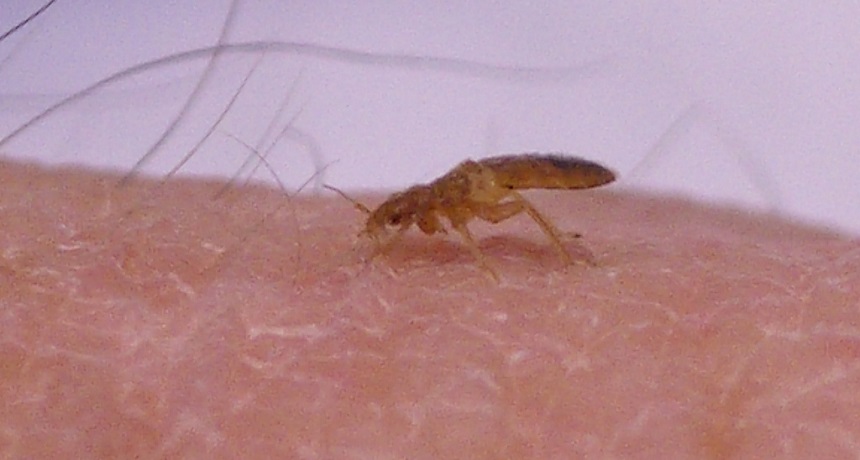Scientists feed bed bugs (on purpose)
Some researchers go to extraordinary lengths to keep bed bugs happy and well fed

Harold Harlan captured this bed bug as it was starting to dine. (Photo has been cropped slightly.)
H. Harlan/ AFPMB / Flickr (CC BY-NC-ND 2.0)
By Brooke Borel
When bed bugs suddenly made a comeback in recent years, biologists were just as surprised as everyone else. Few had studied the bugs because there seemed no need to do so. But as bed bugs became ever harder to kill, scientists began probing hard to find their weaknesses.
To do that, they invited some of the bugs to stay in the lab. There, researchers could observe them closely. But to be good hosts, the scientists had to keep their bugs healthy and well-fed. And that has required learning how to deliver these critters the blood on which they thrive.
In the beginning, scientists didn’t know. But they figured a good first step was to recreate key features of the human body. For instance, they worked to warm the blood to the right temperature. And they had to enclose it in a skin-like membrane for the bugs to pierce with their needle-like mouths.
Scientists at the Ohio State University in Columbus took a short-cut. They turned to ready-made feeders that had originally been designed to nourish other bloodthirsty insects in the lab: mosquitoes.
Still other scientists took a more old-school approach. They fed the bugs from their own arms and legs.
Harold Harlan became especially famous for this. A former entomologist with the U.S. Army, he had found bed bugs at an army base in New Jersey. This was during the early 1970s. Back then it was very rare to find any live bed bugs. So he brought some to his lab to study in his spare time. He raised them on his own blood. And he still does so today — more than 40 years later!
Harlan has kept his bed bugs away from insecticides this entire time. As a result, these insects are more sensitive to the chemical insect killers than are the bed bugs infesting our homes. And that makes his critters quite valuable to scientists. Many ask to use some of his bed bugs in experiments to probe how they differ from the poison-defying “super bed bugs.”
Harlan’s bugs also were the first to be used in two major projects aimed at mapping the bed-bug genome.These studies are attempting to identify all of the different genes in this insect. Such information could help scientists one day find ways to better control the pests.
The Bed Bug Genome Consortium is conducting one of the studies. Some two dozen researchers from all over the world are collaborating on it. Scientists from Weill Cornell Medical College, the American Museum of Natural History and Fordham University are taking part in a related investigation. (All three of those institutions are in New York City.)
This research can be difficult. It also will likely take a long time to complete.
Power Words
(for more about Power Words, click here)
bed bug A parasitic insect that feeds exclusively on blood. The common bed bug, Cimex lectularius, sucks human blood and is mainly active at night. The insect’s bite can cause skin rashes and welts that sometimes look like a mosquito bite, but different people react in different ways.
consortium A group or association of independent organizations.
entomology The scientific study of insects. One who does this is an entomologist
gene (adj. genetic)A segment of DNA that codes, or holds instructions, for producing a protein. Offspring inherit genes from their parents. Genes influence how an organism looks and behaves
genome The complete set of genes or genetic material in a cell or an organism. The study of this genetic inheritance housed within cells is known as genomics.
infest To create a parasitic community, such as when wasps infest the porch of an abandoned house. Such a community of pests is known as an infestation.







